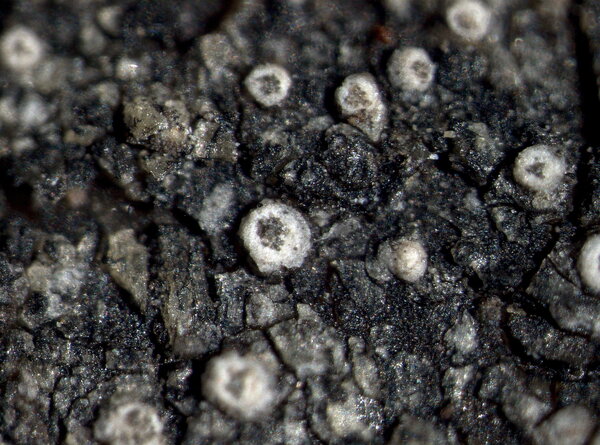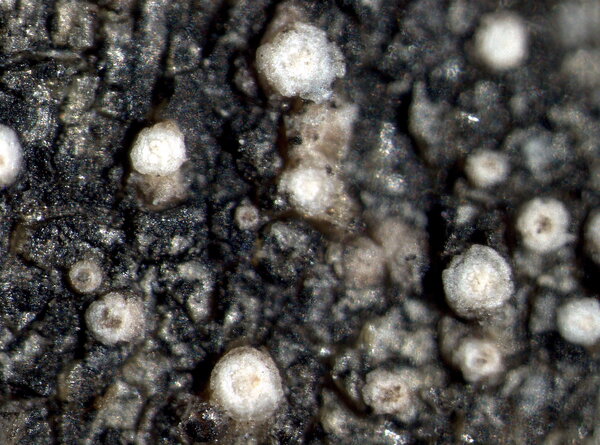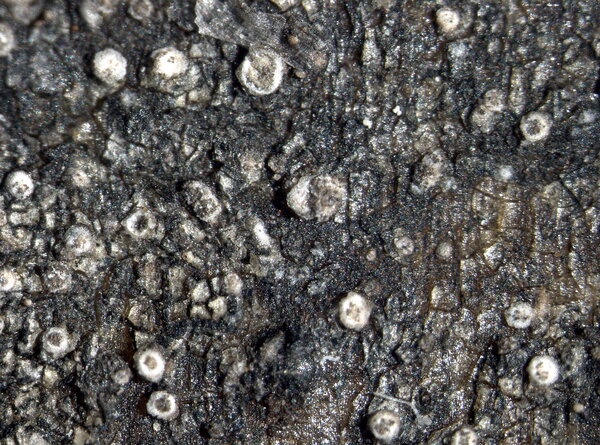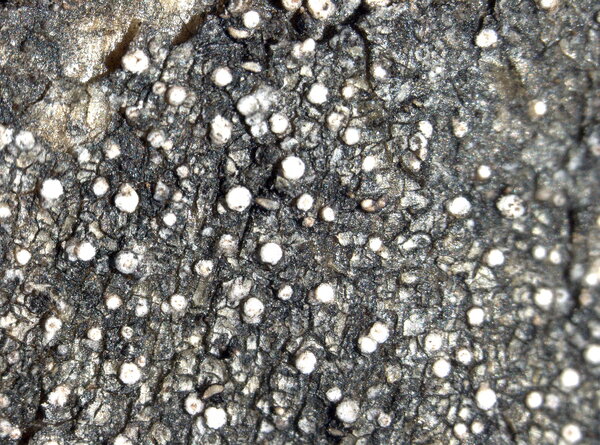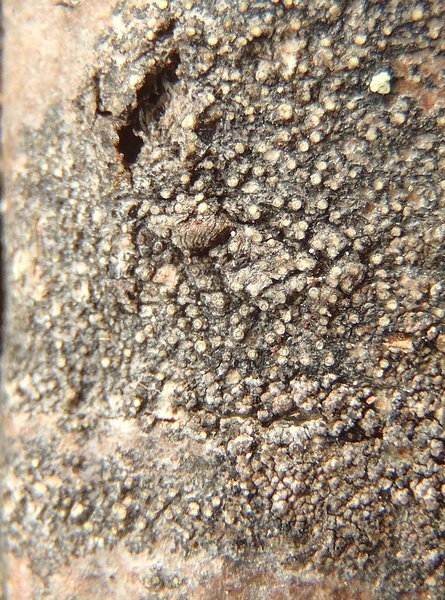Lendemeriella sorocarpa (Vain.) S.Y. Kondr.
in Kondratyuk & al., Acta Bot. Hung., 62, 1-2: 121, 2020. Basionym: Placodium sorocarpum Vain. - Ann. Soc. zool.-bot. Fenn., 9: 320, 1929.
Synonyms: Caloplaca sorocarpa (Vain.) Zahlbr.
Description: Thallus crustose, continuous, areolate or warted, rather thin, greenish white to greenish grey or grey, often delimited by a dark prothallus, with numerous, perfectly circular, (0.1-)0.25-0.5 mm wide, at first immersed, then protruding to almost stipitate and barrel-shaped, whitish to greenish grey soralia which are often surrounded by a whitish, thin thalline rim. External soredia brown, up to 20(-30) µm in diam., surrounded by a continuous wall of more or less isodiametrical (up to 7 µm wide) to somewhat elongate cortical cells, the brown pigment K+ fuscous brown, N+ reddish brown. Apothecia extremely rare, 0.2-0.3 mm across, at first immersed, then sessile, with a concave to flat, rusty-orange to red-brown, rough disc, a thin proper margin, and sometimes a poorly developed thalline margin. Proper exciple brownish in outer part, colourless within, of radially arranged hyphae, sometimes overlain by a paraplectenchymatous thalline exciple in lower part; epithecium reddish orange, K+ purple-red, with a granulose epipsamma; hymenium colourless, 70-80 μm high; paraphyses simple or rarely sparingly branched, 2-3.5 μm thick, not or slightly swollen at apex; hypothecium colourless. Ascospores 2-celled, polarilocular, hyaline, ellipsoid, 8-15 x 5-8 μm, the equatorial thickening (“septum”) 2-4.5 μm. Pycnidia rare, orange to red-brown. Conidia bacilliform, 4.5-6 x c. 1 μm. Photobiont chlorococcoid. Spot tests: thallus K-, C- or C+ pale yellow (soralia only), KC-, P-; pigmented external soredia K+ fuscous brown, N+ reddish brown; apothecial disc K+ purple-red, C-. Chemistry: thallus with roccellic acid; apothecia with different anthraquinones.
Growth form: Crustose
Substrata: bark
Photobiont: green algae other than Trentepohlia
Reproductive strategy: mainly asexual, by soredia, or soredia-like structures (e.g. blastidia)
Commonnes-rarity: (info)
Alpine belt: absent
Subalpine belt: rather rare
Montane belt: extremely rare
Dry submediterranean belt: absent
Humid submediterranean belt: absent
Padanian area: absent
pH of the substrata:
1 2 3 4 5
Solar irradiation:
1 2 3 4 5
Aridity:
1 2 3 4 5
Eutrophication:
1 2 3 4 5
Poleotolerance:
0 1 2 3
Altitudinal distribution:
1 2 3 4 5 6
Rarity
absent
extremely rare
very rare
rare
rather rare
rather common
common
very common
extremely common
Loading data...
Occurrence data
Predictive map
Growth form: Crustose
Substrata: bark
Photobiont: green algae other than Trentepohlia
Reproductive strategy: mainly asexual, by soredia, or soredia-like structures (e.g. blastidia)
Commonnes-rarity: (info)
Alpine belt: absent
Subalpine belt: rather rare
Montane belt: extremely rare
Dry submediterranean belt: absent
Humid submediterranean belt: absent
Padanian area: absent
pH of the substrata:
| 1 | 2 | 3 | 4 | 5 |
Solar irradiation:
| 1 | 2 | 3 | 4 | 5 |
Aridity:
| 1 | 2 | 3 | 4 | 5 |
Eutrophication:
| 1 | 2 | 3 | 4 | 5 |
Poleotolerance:
| 0 | 1 | 2 | 3 |
Altitudinal distribution:
| 1 | 2 | 3 | 4 | 5 | 6 |
Rarity
absent
extremely rare
very rare
rare
rather rare
rather common
common
very common
extremely common
Loading data...
Occurrence data
Predictive map


